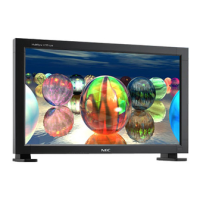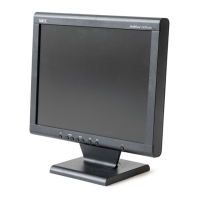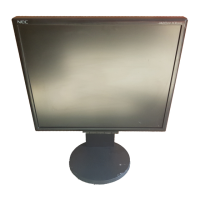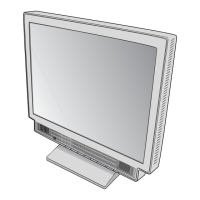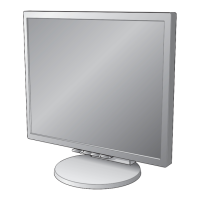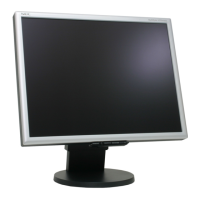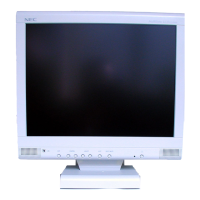
Do you have a question about the NEC MultiSync LCD3215 and is the answer not in the manual?
| Pixel pitch | 0.511 x 0.511 mm |
|---|---|
| Aspect ratio | 16:9 |
| Response time | 9 ms |
| Display diagonal | 32 \ |
| Display resolution | 1360 x 768 pixels |
| Vertical scan range | 50 - 85 Hz |
| Horizontal scan range | 31.5 - 91.1 kHz |
| Contrast ratio (typical) | 800:1 |
| Display number of colors | 16.78 million colors |
| Display brightness (typical) | 500 cd/m² |
| Audio input | Yes |
| DVI-D ports quantity | 1 |
| DVI-I ports quantity | 0 |
| Product color | Black |
| Market positioning | - |
| Panel mounting interface | 400 x 200 mm |
| Power consumption (typical) | 115 W |
| Operating temperature (T-T) | 5 - 40 °C |
| Operating relative humidity (H-H) | 20 - 80 % |
| Depth (without stand) | 133 mm |
|---|---|
| Width (without stand) | 789 mm |
| Height (without stand) | 476.3 mm |
| Weight (without stand) | 13100 g |
Certifies compliance with EU directives and standards for the MultiSync LCD3215/LCD4215 monitors.
Covers critical warnings about electrical hazards, liquid spills, object insertion, and proper handling.
Guidance on optimal monitor placement, viewing comfort, and ergonomic setup for enhanced user experience.
Instructions for safely cleaning the LCD panel and monitor cabinet using appropriate materials.
Guidelines for orienting the monitor, especially in portrait mode, for optimal ventilation and longevity.
Covers safe wall and ceiling mounting, location requirements, and proper screw usage for stability.
Instructions for periodic inspection of mounting hardware and location for signs of wear or damage.
Guidance on attaching VESA-compatible accessories and the optional table top stand.
Covers ventilation requirements and measures to prevent the monitor from tipping over.
Details the function of each button on the monitor's control panel for operation and menu navigation.
Explains the power indicator light and the main power switch for controlling monitor power.
How to enable and disable the control key lock to prevent accidental adjustments.
Details all input and output connectors, including AC IN, RGB, DVI, VIDEO, AUDIO, and external speaker terminals.
Information on RS-232C connectivity for remote control and Kensington Lock for security.
Covers power, input selection, volume, mute, and display information controls.
Details on adjusting picture size, picture mode, audio input, and volume levels.
Explains functions like PIP/POP, Still Picture, Auto Setup, and menu navigation.
Details the effective distance, angles, and environmental conditions for remote control operation.
Instructions for proper handling, avoiding shock, liquids, heat, and unauthorized access to the remote.
Determining the installation site and following safety precautions for monitor setup.
Instructions for installing remote control batteries and connecting external equipment and power cord.
Steps for powering on equipment, operating external devices, and performing initial sound adjustments.
Covers screen position, image settings, recommended adjustments for persistence, and power switch security.
Illustrates the connection paths for various external devices like DVD players, VCRs, and PCs.
Demonstrates connections for DVD players, VCRs, PCs, and equipment with digital interfaces.
Information on factory preset signal timings for optimal display resolution and scanning frequencies.
Step-by-step guide for connecting the monitor to a PC via analog RGB (mini D-sub, BNC) and audio inputs.
Details on connecting the monitor to computers with digital outputs using DVI-D cables.
Instructions for connecting a DVD player via component output (BNC) and setting the correct input mode.
Guide for connecting the monitor's audio output to a stereo amplifier using audio input/output jacks.
Details the methods for powering the monitor on and off using the control panel and remote control.
Covers power indicator status, using power management for energy saving, and recommended settings.
How to select video sources, adjust picture size, picture mode, and understand information OSD.
Step-by-step guide on using remote control and panel buttons to access and move through OSD menus.
How to select functions and adjust settings within the OSD using the +/- and Up/Down buttons.
Detailed descriptions of PICTURE settings including brightness, contrast, color, and temperature.
Explanation of ADJUST settings such as Auto Setup, Position, Clock, and Zoom Mode.
Details on zoom, position, resolution adjustments, and menu resets for the ADJUST section.
Covers audio adjustments, scheduling monitor activation, and Picture-in-Picture configuration.
Settings for OSD language, display timeouts, positioning, and information display.
Covers IR control, Tile Matrix for multi-screen display, and power on delay settings.
Includes Power Save, Screen Saver, Gamma, Cooling Fan, Brightness, Motion, and Side Border Color options.
Covers DVI mode selection, scan conversion (IP function), and color system settings.
Includes scan mode, black level expansion, and reset options for advanced settings.
Procedure for restoring all monitor settings to their original factory defaults.
Detailed guide for setting up scheduled activation times and input sources for the monitor.
Explains LCD Image Persistence and provides methods to prevent image sticking for longer life.
Details connecting the monitor to a PC via RS-232C and specifies interface parameters.
Provides information on using control commands for PC-based monitor operation via RS-232C.
Summarizes major features including Reduced Footprint, Color Control, OSD, Plug and Play, IPM, and VESA mounting.
Resolves issues like no picture, unstable images, green tint, incorrect sizing, and resolution display.
Addresses problems with power buttons, no sound, unresponsive remote controls, and LED indicators.
Troubleshoots image persistence, schedule/off timer functions, and blinking red LED errors.
Comprehensive data on LCD module, frequency, input signals, output signals, control, environment, and accessories.
Comprehensive data on LCD module, frequency, input signals, output signals, power, and environmental requirements.
Details the pin assignments for the analog RGB VGA and VIDEO(S) input connectors.
Details the pin assignments for the DVI-D digital RGB input and RS-232C serial input connectors.
Provides information on responsible disposal and recycling of NEC products, including website resources.
Details the monitor's energy saving modes and compliance with European WEEE Directive for waste disposal.
